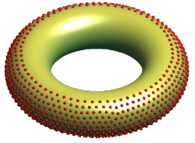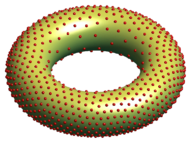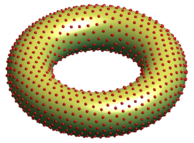Poppy-seed bagel theorem
The poppy-seed bagel theorem is a cool idea in physics that helps us understand how tiny particles spread out on a surface. Imagine you have a bagel covered in poppy seeds. If these seeds could push each other away, how would they arrange themselves to be as comfortable as possible?
This theorem says that if particles (like electrons or poppy seeds) are on a surface (like a bagel) and they push each other away, they will spread out very evenly. This happens when the pushing force is strong enough. It's like each seed wants its own space and tries to get as far away from its neighbors as possible. When they all do this, they end up nicely spread out across the whole surface. This idea is important for understanding things like electricity and how particles behave in different spaces.
How Particles Spread Out: The Energy Idea
Particles that push each other away have something called "energy." The closer they are, the higher their energy. To be stable and "happy," these particles try to arrange themselves so their total energy is as low as possible. Think of it like a group of friends trying to find the most comfortable spots in a room – they'll naturally spread out so no one feels too crowded.
Scientists use math to describe this pushing force. It's often related to the distance between particles. For example, the force might get weaker the further apart the particles are. The "poppy-seed bagel theorem" tells us that if this pushing force is strong enough, the particles will end up spreading out almost perfectly evenly across the surface.
The Bagel Analogy: Spreading Seeds Evenly
Let's go back to our bagel. If you want to make a "perfect" poppy-seed bagel where every bite has about the same number of seeds, you'd want the seeds to be spread out evenly. The theorem says that if the poppy seeds could repel each other with a strong enough force (like a force that gets weaker by the square of the distance between them, or even stronger), they would naturally arrange themselves into a nearly perfect, even pattern.
This idea works for many different shapes, not just bagels! It applies to particles on flat surfaces, inside 3D objects, or on curved surfaces like a sphere. The key is that the pushing force between the particles needs to be strong enough compared to the "dimension" of the space they are in. For a 2D surface like a bagel, the force needs to be at least as strong as an "inverse square distance" repulsion.
The images above show how 1000 particles arrange themselves on a torus (a donut or bagel shape) depending on how strong their pushing force is. When the force is weak, they clump together. But when the force is strong enough, they spread out almost perfectly evenly, just like the theorem predicts!




